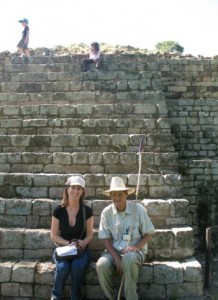
Author Amy E. Robertson and guide Antonio seated on one of the small pyramids in Copán’s Great Plaza. Photo © Luca Renda.
I stood next to the old man’s head. No, not a human head, but one carved in stone.“It is believed that the head belonged to one of four giant statues of the Pawahtun, deities that the Maya believed held up the four corners of the earth,” said my guide, Antonio. That’s a heavy load to carry. No wonder a grimace was carved into the face.
I followed Antonio down the staircase leading to the Great Plaza of Copán, with its Hieroglyphic Stairway of 1,093 glyphs, its Ball Court with macaw heads carved in stone, and its smaller pyramids and stelae (carved statues) that dot the grassy square. Lanky and wrinkled, Antonio has been working at Honduras’s most important Mayan ruins for decades, not just with tourists, but also with the archaeologists that come from time to time to painstakingly unearth temples and other treasures in the hillocks. Antonio was a multilingual wellspring of Mayan history. I’d been to Copán four times in as many years, and he was managing to add to what I already knew about the place, punctuating his scholarship with plenty of jokes and smiles.
The glory of travel writing isn’t in fame or celebrity. (Before I became a guidebook writer, I don’t even think I ever noticed that guidebooks have author names attached.) The glory is that which is defined as magnificence, splendor, sublimity. Experiencing places like Copán with people like Antonio. Helping visitors make the most of their time in Honduras, a country I fell in love with during my five years living there. Helping Hondurans (and I confess to a predilection for family-run businesses and community-tourism efforts), as they work to attract tourists, share the beauty of their country, and reap the associated economic boost.
The glory of travel writing isn’t in fame or celebrity. Before I became a guidebook writer, I don’t even think I ever noticed that guidebooks have author names attached.The morning came to an end all too soon; I had ground work to do. I needed to get back to the colonial town of Copán Ruinas, a kilometer from the ruins themselves, where I would stop by some 60 hotels, restaurants, and businesses over the next few days. Pounding the pavement, or rather, the cobblestones, asking to see rooms and checking the cleanliness of showers and toilets, peeking at menus and jotting down prices, asking everyone I met about their favorite place to eat, scratching out businesses that have closed since the previous edition of Moon Honduras, scribbling down details of new ones. The more establishments I could check out that day, the more time I would have the following, to squeeze in a visit to the macaw reserve or thermal baths outside of town.After the in-person groundwork, details have to be filled out by yet more research, and then comes the grind: typing up those pages and pages of notes. My time at the computer is likely triple the hundreds of hours I log traveling around Honduras for each edition of the guide. I send emails and make calls to check for new developments and verify prices. I look at comments online about the establishments I’ve visited, as well as look for anything recommended that I might have missed. It’s impossible to stay in every hotel or eat in every restaurant, but online reviews enable me to hear from many more people about their experience—though I always read them with caution.
Because of the quantity of time involved in researching, writing, and publishing a book, changes always occur between when a writer has done his or her research and the reader is presented with the informationThat said, online information can be a valuable complement to a good guidebook, alerting travelers to openings, closures, and changes. Because of the quantity of time involved in researching, writing, and publishing a book, changes always occur between when a writer has done his or her research and the reader is presented with the information—especially with books, which cover thousands of businesses and points of interest, and take months to research, write and publish. It’s that enormous scope, however, that allows guidebooks to offer so much more than online reviews. There are implicit and explicit comparisons among businesses and points of interest across the entire area covered—such as the 10 Day Best of Honduras. There are suggestions as to what can’t be missed, not just in one place, but in a region or country. There’s historical, cultural, and practical information, all pulled together in one handy place. For a good travel writer, the work is both a responsibility to be taken seriously, as well as a commission to enjoy.And enjoy it I do, savoring each moment of discovery. Snorkeling by yellow damselfish and colorful coral at the Blue Channel in Roatán’s reef; Learning how to make traditional pottery from an indigenous woman in the mountains of central Honduras; Hiking in the cloud forest of Pico Bonito, guided by a youth from a local community organization; Spotting a toucan in the wild; Visiting the tiny islands of the Cayos Cochinos and the fabled Mosquito Coast through community-based tourism projects; Climbing to the top of a Mayan pyramid at Copán.
Is there glory in travel writing? Yes. There are more than enough moments to satisfy a traveler’s soul.